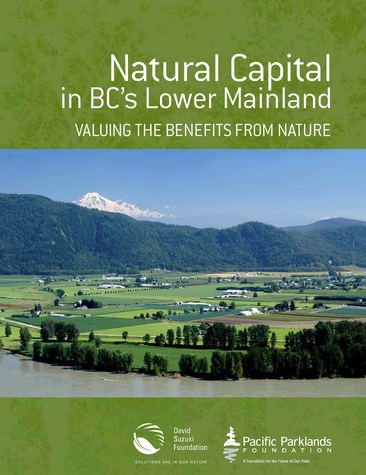Natural Capital in BC’s Lower Mainland: Valuing the Benefits from Nature
Recognizing the Value of Nature
British Columbia.’s Lower Mainland provides natural benefits in the order of $5.4 billion a year, or close to $2500 per person annually, according to a study released in November 2010 by the David Suzuki  Foundation and Pacific Parklands Foundation. The report examines the extent of natural capital — the forests, fields, wetlands and other ecosystems — in the Lower Mainland region and its watersheds, and for the first time estimates economic values for the benefits these ecosystems provide.
Foundation and Pacific Parklands Foundation. The report examines the extent of natural capital — the forests, fields, wetlands and other ecosystems — in the Lower Mainland region and its watersheds, and for the first time estimates economic values for the benefits these ecosystems provide.
The study estimates values for various benefits provided by nature, such as filtering our air and water, combatting climate change by absorbing and storing carbon dioxide, and protecting us from storms and floods. The study examined B.C.’s Lower Mainland region, encompassing Metro Vancouver, the Fraser Valley and surrounding watersheds, extending to the communities of Hope and Squamish. The region contains some of Canada’s best agricultural lands, wetlands and forests; however, sprawling development remains a major threat to the region’s natural capital, with the population expected to grow to three million by 2020.
 “Nature provides these services for free, but the benefits can no longer be ignored,” said David Suzuki Foundation science director Faisal Moola. “This study shows that it is time to start accounting for the economic value of nature’s benefits in how we manage the growth of our towns and cities.”
“Nature provides these services for free, but the benefits can no longer be ignored,” said David Suzuki Foundation science director Faisal Moola. “This study shows that it is time to start accounting for the economic value of nature’s benefits in how we manage the growth of our towns and cities.”
The study found the ecosystems with the highest values to be wetlands ($4,000 to $6,000 per hectare) and forests ($5,900 to $7,400 per hectare). The greatest economic benefits were climate regulation ($1.7 billion per year), water supply ($1.6 billion) and flood protection and water regulation ($1.2 billion).
“Ecosystem services are too often taken for granted by decision-makers,” said Nancy Olewiler, director of the School of Public Policy at Simon Fraser University. “Research shows that replacing natural capital with built substitutes such as water-treatment plants and retention walls can cost hundreds of millions of dollars. And these replacement costs are only one portion of the true value of nature in sustaining life on our planet.”
The study also found that more than 1,300 hectares of rare wetlands have been lost in the last two decades, mostly through urban development. This represents a loss of more than $11 million in ecosystem services each year.
“It is our hope that by providing economic values for ecosystem benefits, decision-makers will recognize the environmental and social benefits of protecting natural capital within our urban areas,” said ecological economist and study author Sara Wilson. “It is encouraging to see that municipal governments in Metro Vancouver have already committed to protect all endangered wetlands by 2015 under Metro’s current Action Plan.”
The study is a first step towards a more comprehensive accounting of natural capital assets in the region and provides a framework for similar studies across Canada.
“This landmark study reinforces the importance of protecting and restoring parklands and green spaces within our Lower Mainland communities and across the country,” said Bryan Wallner, Vice President of the Pacific Parklands Foundation.
The report, Natural Capital in B.C.’s Lower Mainland, and related materials are available at www.davidsuzuki.org or www.pacificparklands.ca.

Posted December 2010

